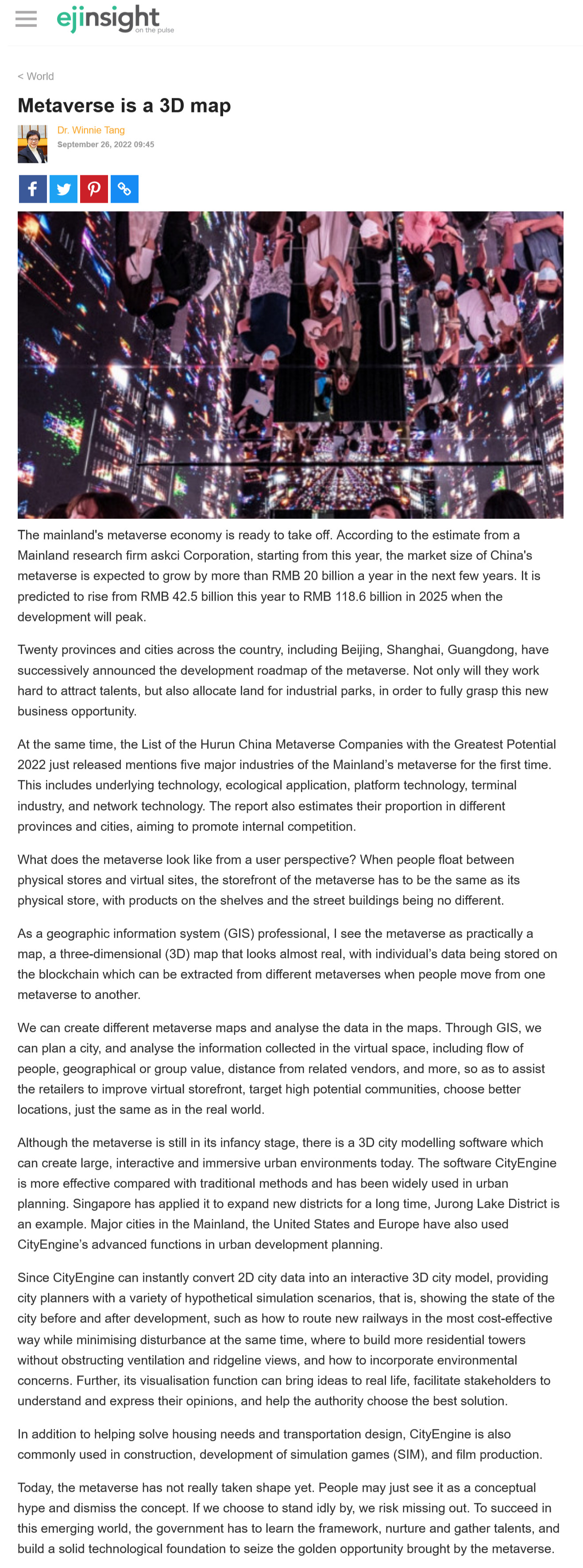網上版請按此

Metaverse is a 3D map
The mainland's metaverse economy is ready to take off. According to the estimate from a Mainland research firm askci Corporation, starting from this year, the market size of China's metaverse is expected to grow by more than RMB 20 billion a year in the next few years. It is predicted to rise from RMB 42.5 billion this year to RMB 118.6 billion in 2025 when the development will peak.
Twenty provinces and cities across the country, including Beijing, Shanghai, Guangdong, have successively announced the development roadmap of the metaverse. Not only will they work hard to attract talents, but also allocate land for industrial parks, in order to fully grasp this new business opportunity.
At the same time, the List of the Hurun China Metaverse Companies with the Greatest Potential 2022 just released mentions five major industries of the Mainland's metaverse for the first time. This includes underlying technology, ecological application, platform technology, terminal industry, and network technology. The report also estimates their proportion in different provinces and cities, aiming to promote internal competition.
What does the metaverse look like from a user perspective? When people float between physical stores and virtual sites, the storefront of the metaverse has to be the same as its physical store, with products on the shelves and the street buildings being no different.
As a geographic information system (GIS) professional, I see the metaverse as practically a map, a three-dimensional (3D) map that looks almost real, with individual's data being stored on the blockchain which can be extracted from different metaverses when people move from one metaverse to another.
We can create different metaverse maps and analyse the data in the maps. Through GIS, we can plan a city, and analyse the information collected in the virtual space, including flow of people, geographical or group value, distance from related vendors, and more, so as to assist the retailers to improve virtual storefront, target high potential communities, choose better locations, just the same as in the real world.
Although the metaverse is still in its infancy stage, there is a 3D city modelling software which can create large, interactive and immersive urban environments today. The software CityEngine is more effective compared with traditional methods and has been widely used in urban planning. Singapore has applied it to expand new districts for a long time, Jurong Lake District is an example. Major cities in the Mainland, the United States and Europe have also used CityEngine's advanced functions in urban development planning.
Since CityEngine can instantly convert 2D city data into an interactive 3D city model, providing city planners with a variety of hypothetical simulation scenarios, that is, showing the state of the city before and after development, such as how to route new railways in the most cost-effective way while minimising disturbance at the same time, where to build more residential towers without obstructing ventilation and ridgeline views, and how to incorporate environmental concerns. Further, its visualisation function can bring ideas to real life, facilitate stakeholders to understand and express their opinions, and help the authority choose the best solution.
In addition to helping solve housing needs and transportation design, CityEngine is also commonly used in construction, development of simulation games (SIM), and film production.
Today, the metaverse has not really taken shape yet. People may just see it as a conceptual hype and dismiss the concept. If we choose to stand idly by, we risk missing out. To succeed in this emerging world, the government has to learn the framework, nurture and gather talents, and build a solid technological foundation to seize the golden opportunity brought by the metaverse.
Dr. Winnie Tang
Adjunct Professor, Department of Computer Science, Faculty of Engineering; Department of Geography, Faculty of Social Sciences; and Faculty of Architecture, The University of Hong Kong